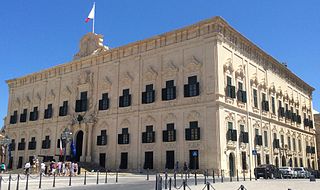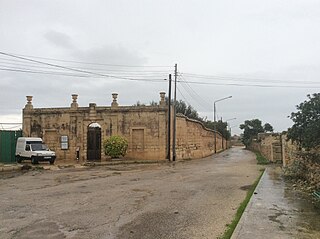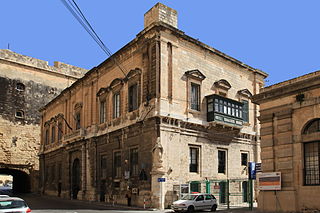

Antonio Cachia (1739–1813) was a Maltese architect, civil and military engineer and archaeologist who was active in the late 18th and early 19th century.

The Maltese are a nation and an ethnic group indigenous to Malta, and identified with the Maltese language. Malta is an island in the middle of the Mediterranean Sea. Included within the ethnic group defined by the Maltese people are the Gozitans who inhabit Malta's sister island, Gozo.
He was the son of the architect Gio Domenico Cachia, who was possibly the same person as Domenico Cachia, the capomastro who supervised the construction of Auberge de Castille. [1] He was a cousin of Michele Cachia, another architect and military engineer. [2]

Domenico Cachia was a Maltese capomastro who was involved in the construction of several notable buildings, including Auberge de Castille in Valletta and St Helen's Basilica in Birkirkara. It is not certain if he was the same person as Gio Domenico Cachia, an architect who was the father of Antonio Cachia.

The Auberge de Castille is an auberge in Valletta, Malta. It was originally built in the 1570s to house knights of the Order of Saint John from the langue of Castile, León and Portugal. The present building dates back to the 1740s, when it was completely rebuilt during the magistracy of Manuel Pinto da Fonseca. The new auberge was built in the Baroque style, and it has been called "probably the finest building in Malta". It now houses the Office of the Prime Minister of Malta.

Michele Cachia was a Maltese architect and military engineer. He is also known for his role during the Maltese uprising of 1798–1800.
Cachia became Capomastro delle Opere in 1779. In 1787, he received the title of Knight Commander of the Order of the Golden Spur by Pope Pius VI. He was in charge of works on various fortifications, including the upgrading of Fort Ricasoli and the construction of Fort Tigné. [2] In Valletta, he designed or built the Church of St. Dominic, [3] the Church of St. Augustine and St. Catherine's Monastery. He is said to have completed the Bibliotheca, which had been designed by Stefano Ittar. [1]

The Order of the Golden Spur, officially known also as the Order of the Golden Militia, is a Papal Order of Knighthood conferred upon those who have rendered distinguished service in propagating the Catholic faith, or who have contributed to the glory of the Church, either by feat of arms, by writings, or by other illustrious acts.

Pope Pius VI, born Count Giovanni Angelo Braschi, was head of the Catholic Church and ruler of the Papal States from 15 February 1775 to his death in 1799.

Fort Ricasoli is a bastioned fort in Kalkara, Malta, which was built by the Order of Saint John between 1670 and 1698. The fort occupies a promontory known as Gallows' Point and the north shore of Rinella Bay, commanding the entrance to the Grand Harbour along with Fort Saint Elmo. It is the largest fort in Malta, and it has been on the tentative list of UNESCO World Heritage Sites since 1998, as part of the Knights' Fortifications around the Harbours of Malta.
Cachia also designed several gardens, including the Ġonna tal-Kmand in various localities around Malta and the Lower Argotti Gardens in Floriana. He also redesigned the Floriana Granaries and the Market House (now known as Middle Sea House). Cachia eventually became chief Superintendent of the Civil dockyard. [1]

The Ġonna tal-Kmand, formerly known as Ġonna tal-Kutnent and sometimes known as Ball Gardens, are a group of gardens in various localities in Malta, which were built in the early years of the 19th century when the island was a British protectorate. The gardens were commissioned by Civil Commissioner Alexander Ball between 1802 and 1805, and were given to the Luogotenenti in charge of the towns or villages.

Floriana, also known by its title Borgo Vilhena, is a fortified town in the South Eastern Region area of Malta, just outside the capital city Valletta. It has a population of 2,205 as of March 2014. Floriana is the birthplace of many famous Maltese, amongst which the composer of the national anthem, 'L-Innu Malti', Robert Samut; former Bishop of Malta Dun Mauro Caruana, the poets Oliver Friggieri & Maria Grech Ganado, the writer and politician Herbert Ganado and Swedish Idol winner Kevin Borg.
Throughout his life, Cachia was a member of several European architectural academies. He died on 6 June 1813. [1]












